Brief
Retailers pulled out all the stops before, during and after Thanksgiving weekend, heightening and extending the Black Friday frenzy. They used aggressive methods to attract shoppers, from offering deeper discounts on doorbusters and cyber deals to connecting with consumers in new omnichannel ways. Deep discounts and expansive marketing campaigns are pressuring margins, making a well-curated and -executed pricing strategy all the more important.
In this issue we recap Thanksgiving weekend performance, highlight innovative retailer tactics and showcase how retailers are using art and science to make tough pricing decisions.
Extending the Black Friday frenzy
Sales estimates for Thanksgiving, Black Friday and the weekend following it differ widely. The National Retail Federation, which asks 4,500 consumers about their spending activity, estimates a 2.9% drop in sales. Other sources suggest sales grew over the four-day period. ShopperTrak, which observes shopping behavior using counting devices and retailers’ sales logs in 50,000 stores, estimates 1% growth in in-store sales. That combined with comScore’s estimated 24% growth in online sales suggests about 3% omnichannel growth from Thursday through Sunday. Either way, the growth rate may not be as relevant as it once was. As retailers continue to turn Black Friday into a month-long shopping event, it is increasingly difficult to draw meaningful conclusions by examining just this four-day period.
Shoppers are spending over more days. Evidence of that is this year’s staggering increase in sales on Thanksgiving (Figure 1). ShopperTrak estimates that Thanksgiving Day spending more than tripled, while Black Friday sales decreased 13%. A joint survey by Bain and PollBuzzer indicates that a whopping 36% of Black Friday weekend shoppers made a purchase on Thanksgiving Day.1 Retailers also expanded outside the weekend. Almost all retailers offered pre-Thanksgiving sales both in stores and online, and some, like Sears and Kmart, offered their Black Friday deals a week in advance. Retailers are also having success by continuing promotions after Black Friday: Cyber Monday sales grew 18% according to comScore, even faster than online sales on Black Friday, and many retailers are continuing to offer discounts throughout “Cyber Week.”
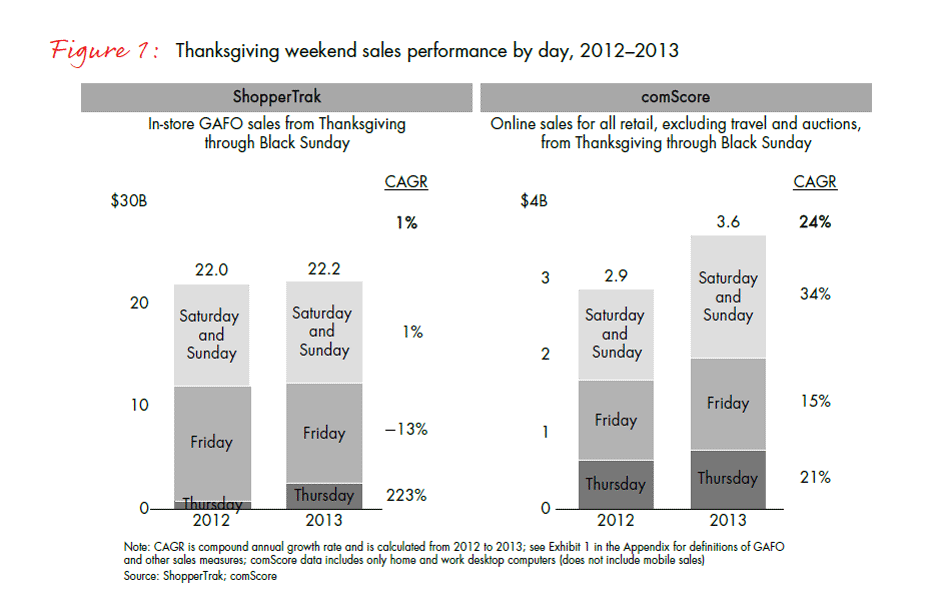
What’s perhaps most striking is how prominent online and mobile shopping has become this holiday season. Over Thanksgiving weekend, almost as many consumers shopped from the comfort of their homes as ventured outside: Bain’s PollBuzzer survey tells us that 59% of shoppers used a website to shop online during the weekend (and 44% of shoppers made an online purchase) compared to 79% who visited a store. Further evidence of the shift to online: Target’s orders per hour on Thanksgiving doubled from last year, eBay’s sales on Cyber Monday were estimated to be up 32% from last year, and Amazon.com’s sales were estimated to be up even more—46%. Those customers who shopped online increasingly used their mobile devices. Adobe estimates that 24% of this year’s Thanksgiving and Black Friday online spend was made on tablets and smartphones, compared to 14% of online spend last year. According to Bain’s survey with PollBuzzer, customers chose to shop online primarily for convenience and to avoid long lines. Those customers who visited a store thought it was the best way to discover new products, get their gifts immediately and secure the best deals.
Retailers served up a generous portion of deals
Retailers continued to rely on headline deals to grab omnichannel shoppers’ attention, and this year’s promotions matched or even exceeded last year’s deep discounts (Figure 2). Target, Walmart and Kmart held relatively steady versus last year. In fact, some headline electronic deals were repeats of last year. Walmart’s lead offer, a 60-inch Vizio television, was on sale again at 2012’s Black Friday price. Other retailers, such as Kohl’s and Best Buy, increased their discounts: Best Buy sweetened its tablet deals, offering 50% off the Kindle Fire and 60% off the Insignia Flex. It even offered a 25% discount on an iPad. By contrast, other retailers pulled back. Sears dropped some of last year’s heaviest discounts on electronics and clothing, but maintained discounts on some of its main attractions such as 50% off a Craftsman tool set. Although many stores led with deals on electronics, the average discount on these headliners (33%) was lower than the average discount (44%) on toys, housewares and clothing.
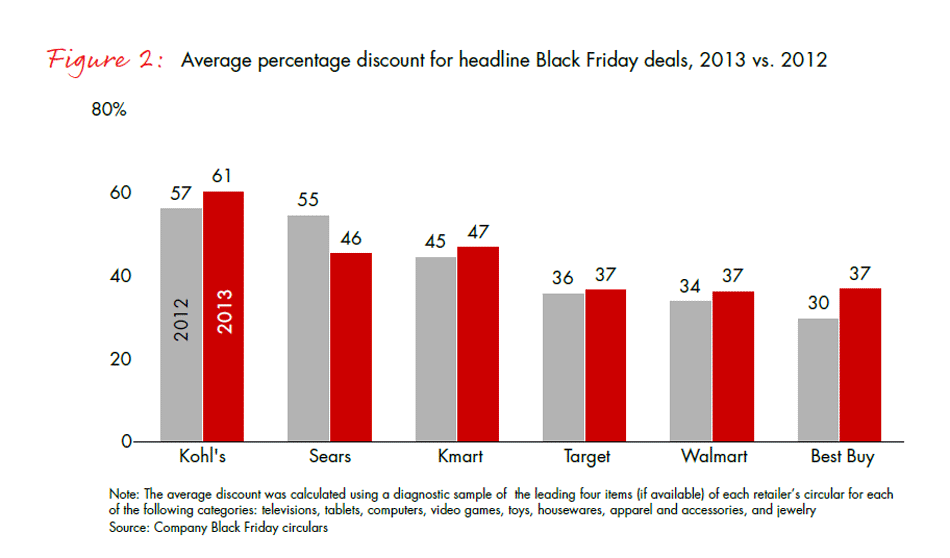
Walmart guaranteed some of its best offers on Black Friday and made sure it had the goods, ordering 65% more televisions and double the number of tablets it did last year. It also matched some of Target’s and Best Buy’s best Black Friday deals on the Friday before Thanksgiving, including Target’s lead Element 50-inch TV (discounted to $229 from $600) and Best Buy’s lead 50-inch LG TV (discounted 25%). Target gave $20 off the coveted iPad Air and also threw in a $100 gift card, a deal that was difficult for others to match. In the meantime, Amazon.com disarmed some other retailers’ best deals. For example, it matched Walmart’s lead Thanksgiving Day offer of a 60-inch Vizio TV for $688, and made it available to customers six days before Thanksgiving. Best Buy, recognizing the trade-off between building early excitement and allowing competitors to match pricing earlier, didn't announce some of its best deals, including a Lenovo touch-screen laptop for $279, until 10 PM on Thanksgiving Day.
Many retailers also used waves of doorbusters to hold shoppers’ attention. Both Walmart and Best Buy launched their first doorbuster at 6 PM Thanksgiving Day, and ended with their third at 8 AM and 10 AM Friday respectively. And doorbusters weren't limited to in-store shoppers. RadioShack kept customers coming back to its website with its “24 deals in 24 hours,” and Amazon.com released a new deal every 10 minutes leading up to and throughout the weekend.
Specialty apparel retailers slashed prices as well. Bain partnered with SaleTally to examine the Black Friday discounts of nine specialty apparel retailers, and found they offered on average storewide discounts of 39% in stores and 40% online, both in line with last year.2 However, over the full month of November, these retailers offered storewide discounts to shoppers many more times this year, from an average of 7.8 days in November 2012 to 11.4 days this year for in-store sales, and from 14.4 days to 15.9 days for online-only sales. Gap was particularly generous: It offered a storewide online discount of 30% or more 22 times in November 2013, compared to just 11 times in November 2012; and the company even had a 50% storewide in store and online sale on Black Friday.
Retailers made holiday shopping more fun
Thanksgiving wasn't only about price promotions. Retailers also explored new ways to make the shopping experience more enjoyable:
- Getting the deal got easier: Walmart continued to guarantee all deals to any shopper in the store between 6 PM and 7 PM on Thanksgiving Day, and gave consumers identifying wristbands so they could shop while they waited. Shoppers also used their mobile devices to find deals more easily in the first place. New apps, including Slickdeals.net’s Black Friday App, notified shoppers in real time about offers, eliminating the need for them to scour circulars across retailers.
- It’s party time: Several retailers transformed shopping into a festival. GameStop held a one-day-only party on Black Friday, with food, freebies and in-store DJs. Barnes & Noble held a similar event on the Friday before Thanksgiving. The retailer’s Discovery Friday featured book signings, discounts on Nooks, story time for children and photo stations where kids and grownups could pose for a picture wearing a Duck Dynasty beard. Google launched a number of Winter Wonderlabs, pop-up stores where visitors can make a movie of themselves playing in a giant snow globe (the "snow" is computer generated). Unsurprisingly, customers waiting in line to film themselves are surrounded by Google products.
- Everyone loves a lottery: Some retailers used giveaways and contests to make shopping more exciting. One shopper at every h.h.gregg store and at hhgregg.com received his or her purchase for free, and customers who played the company’s Endless Blitz game increased their chance of winning. Zappos.com delighted Thanksgiving travelers by turning the baggage claim area into a game show: Anyone whose bag landed on a specific spot on the carousel could win a free pair of shoes from an employee dressed as a turkey. And one shopper got much more than his doorbuster on Black Friday—he won $1 million in Old Navy clothing.
The year of omnichannel marketing
Retailers are bringing their A game to omnichannel messaging this holiday season. Many of their marketing campaigns make use of a number of advertising channels—from online, mobile and television to radio, billboards and the store experience. But each retailer is using its expansive campaign in a different way to reinforce its unique brand positioning:
- A magical experience: Macy’s is bringing more magic to its annual Believe campaign, using more delivery channels than ever before. Customers who submit photos of themselves mailing a letter to Santa inside a Macy’s store using Instagram or Twitter have the chance to be part of a Macy’s television commercial that will air over Christmas. The campaign also showcases a mobile-optimized site to provide a convenient way for consumers to mail a letter to Santa while also signing up to receive texts about deals. And as it did last year, the campaign features a Facebook game, school theater productions and television specials—not to mention the Believe hot-air balloon in the retailer’s Thanksgiving Day Parade. Consumers can connect with Macy’s holiday story inside a store, on their computers at home, on their mobile devices in class, while checking Twitter on the bus or while standing on Sixth Avenue watching the parade.
- It’s all about value: JCPenney’s Jingle More Bells campaign is exploiting many channels, from television and print to email and mobile advertisements, to court consumers with the message that good value allows for more generous gifting. The campaign features a new musical television spot every week, with slogans like “All I want for Christmas is my two-day sale” and “More fa la la for less moo la lah.”
- Sharing your traditions and style: Target is harnessing social media for its My Kind of Holiday campaign. Customers share their family traditions and holiday experiences on Facebook and Twitter using the #MyKindofHoliday hashtag. The retailer is also making use of its Pinterest page. It has partnered with event producer David Stark to help consumers design their own parties: Several hundred REDcard members will receive a personalized Pinterest party board from Stark, complete with design and how-to recommendations for their parties.
One theme we noticed across marketing campaigns this year was the increased use of social media. We partnered with SaleTally to track Facebook posts per month across nine apparel retailers, and found that posts were up 27% over the past six months, from an average of 44 posts per retailer per month in May to an average of 56 posts in November.
The art and science of pricing
This season’s expansive marketing campaigns and deeper promotions are creating an even greater need for a finely tuned pricing strategy to recoup those investments. Retailers know all too well the tightrope they need to walk—offering value to consumers while still making enough profit to sustain and grow their business. That means complicated decisions about the role of products and categories, the timing and frequency of price changes, and whether and how to match prices. Many retailers use analytical methods along with solid business judgment to strike the right balance.
Some products are for the top line; others, for the bottom line
Black Friday weekend offered an opportunity to explore retailers’ pricing strategies. Some used products to attract consumers to stores, pricing those products as competitively as possible. Case in point: Most mass retailers used electronics as their headline doorbuster, but there was significant variation in the specific assortment of deals each retailer offered. For example, Sears focused more on tools and appliances, while Walmart kept its focus on toys (Figure 3).
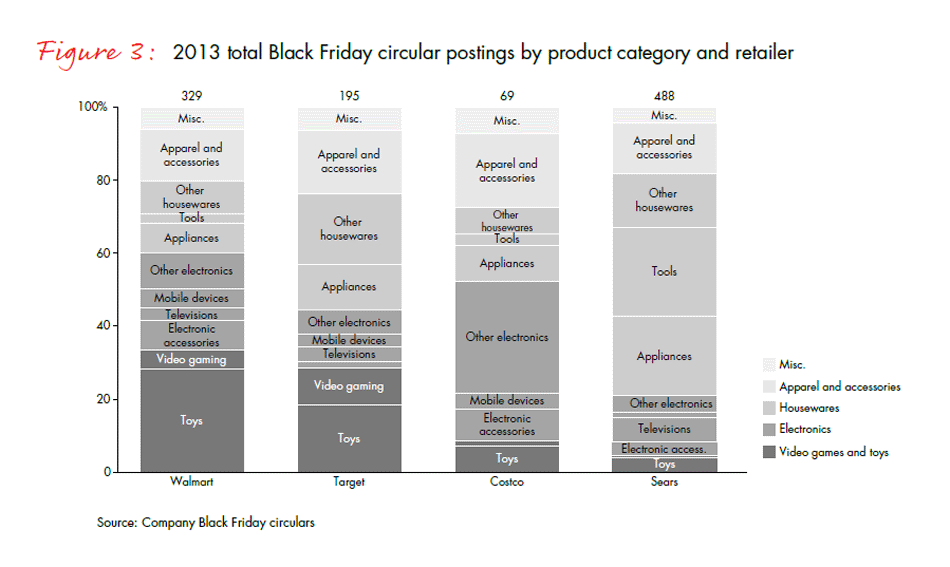
Promotions can drive traffic to stores, apps or websites, but retailers hope to sell those customers other products that are more profitable. Many retailers took advantage of consumers’ perception of Black Friday deals to sell other products that were not always as generously priced. Once consumers find a deal on one product, they sometimes assume other products at that retailer are as good of a value. And sometimes it’s a question of convenience. Comparison shopping takes time that busy consumers often don’t have.
Bain partnered with 360pi to examine how Amazon.com and Walmart priced their assortments against other retailers.3 We examined baskets of products in seven categories to understand the pricing strategies of retailers in each category.4 We selected the most widely sold products to include in each basket to maximize the number of retailers for which we could compare like-for-like pricing. Our analysis yielded some surprising results:
- Amazon.com had the lowest average prices for most categories we tested, but not all: Staples undercut the online retailer’s prices on tablets, and Adorama had the lowest prices on digital cameras.
- Even more surprising: Walmart had the largest assortment of low-end products but never the lowest prices in the seven categories we tested. On televisions, Walmart was beaten by Best Buy and Sears; on tablets, it was beaten by Staples and Best Buy; and on power drills, it was beaten by Sears, The Home Depot and Lowe’s. And consumers using Target’s REDcard to earn 5% off paid less for video games at Target than at Walmart.
We also partnered with 360pi to look at how Amazon.com priced its entire assortment for each category (not just those products that had overlap with a large number of other retailers) and found that while Amazon.com often had the lowest average price in a category, it often did not have the lowest price for any specific product: Amazon.com’s offering was least competitive in tablets and televisions, where it had the lowest price 57% and 48% of the time respectively (Figure 4).
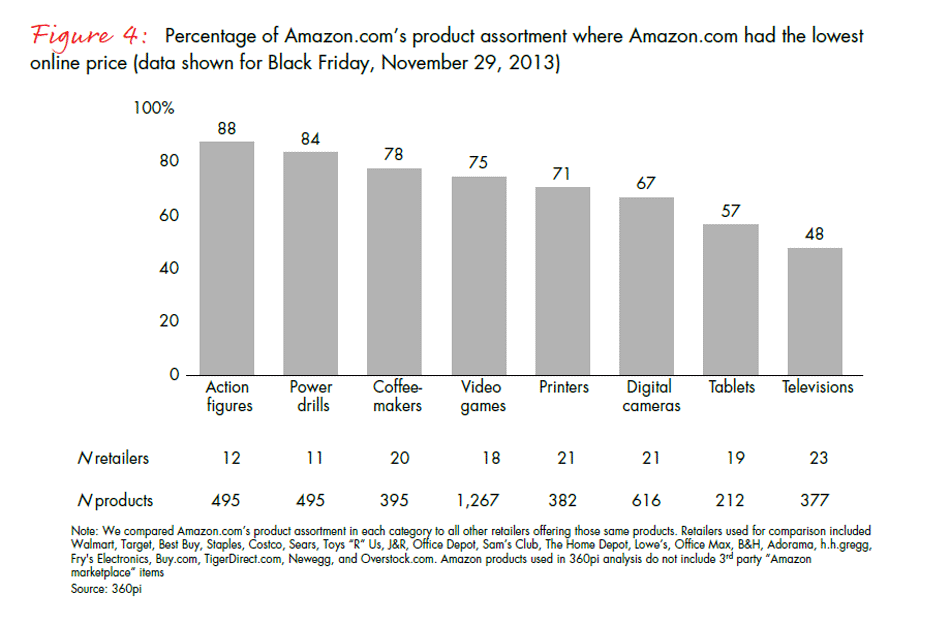
Dynamic pricing: How often, when and where to change prices
The decision on how frequently to change prices involves a balance between staying competitive in the market and retaining customers’ trust. Bain and 360pi examined how often retailers were changing their prices online, and found that, on average, online price change frequency was fairly similar across categories: between two and five days with price changes a month (Figure 5). However, this average hides a great deal of variation; for example, Amazon.com only changed the price for 10-15% of its televisions on any given day in November, but it changed the price of one iPad Air cover seven times on Black Friday alone.
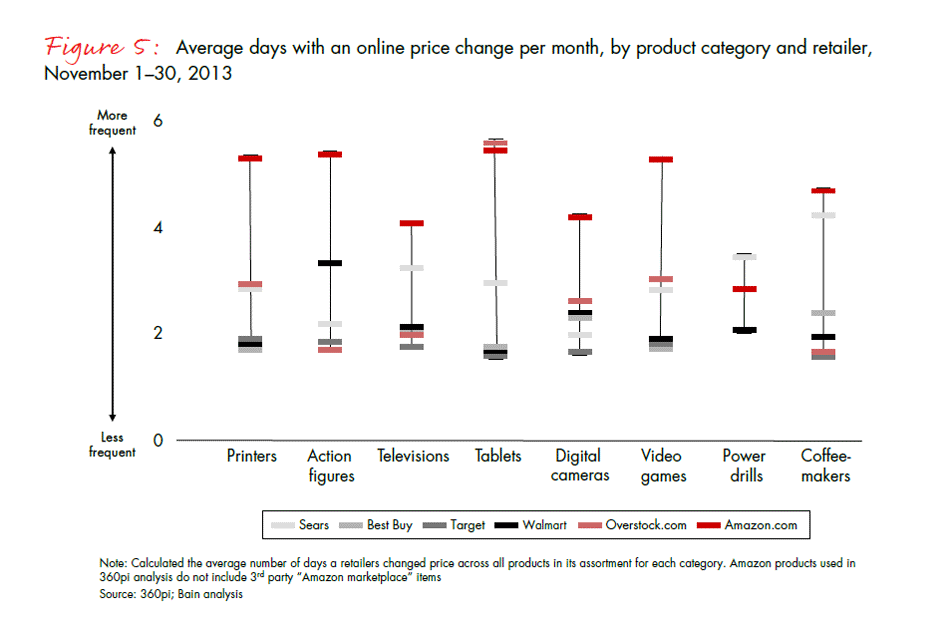
Amazon.com was among the most frequent online price updaters across all categories, typically changing its prices on four to five days a month. Other retailer decisions appear to be category-specific; Walmart was among the more frequent updaters in online action figure pricing, but among the least frequent updaters in online tablet pricing.
A number of factors can trigger price changes, including holidays, a competitor’s decision to lower the price of a particularly visible product or the need to unload excess inventory. Bain and 360pi took a closer look at televisions to understand price-change activity during November (Figure 6). Amazon.com maintained a relatively high level of daily price changes throughout the month. Other retailers chose to pick their spots: Best Buy and Target tended to change prices weekly, usually on Sunday (November 3, 10, 17, and 24). Walmart, on the other hand, changed more than 15% of its prices early in the month and then changed very few of its prices until November 20. All retailers responded similarly heading into Black Friday, with a dramatic increase in the number of price changes on November 25, the Monday before Thanksgiving. In fact, each retailer we examined changed more prices on that Monday than they did on Black Friday.
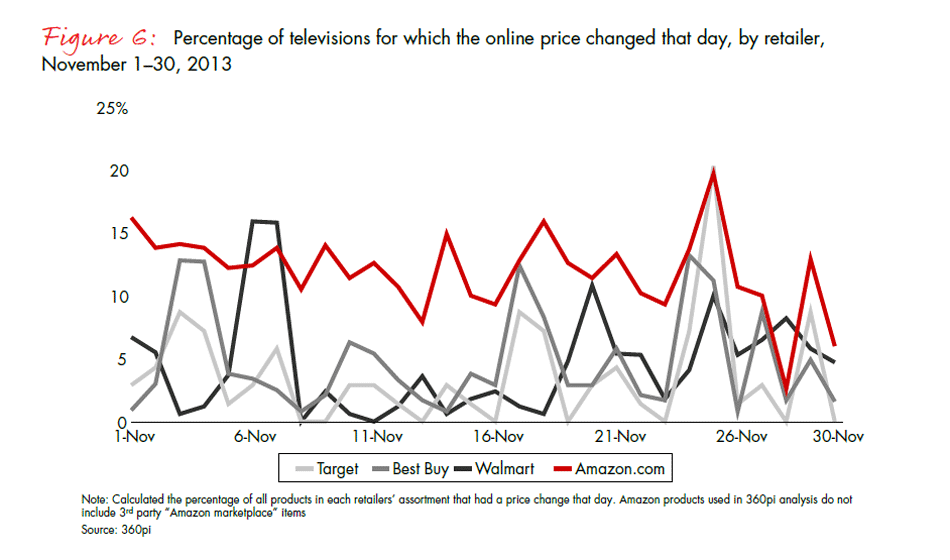
Retailers’ decisions about how often and when to change pricing are also complicated by the fact that many consumers expect the same prices across channels, online and in stores. But even retailers that update online pricing frequently do not update in-store prices with the same regularity.
Price matching: It’s much more than just the guarantee
Price matching has become a popular strategy, and many retailers have expanded their programs in time for the holidays (see Exhibit 2 below). Target’s usual policy is to match prices only within seven days of a purchase; for the holiday, it extended its price-matching window from November 1 through December 24 (excluding Black Friday). Walmart has extended its program through December 24 too, offering refunds in the form of gift cards. Best Buy retooled its policy late in the month: On November 21, it announced that it would allow post-purchase price matching, with cash refunds, through Christmas Eve.
In the past, price guarantees have been a way to reassure consumers that they don’t need to actually check pricing. However, Bain’s PollBuzzer survey shows that 10% of this year’s Black Friday in-store shoppers used a price-matching guarantee over the Black Friday weekend—proof of the significant impact price matching can have on a retailer’s bottom line.
How retailers choose to execute price matching is just as important as the decision to match prices. Retailers are using several types of rules this holiday season to optimize their programs:
- Inventory controls: Many of the best-priced products don’t last, and several retailers don’t match prices on out-of-stock items. Other retailers take this a step further: Target, Best Buy and Toys “R” Us do not match prices for items that are advertised as “limited quantity.”
- Geographic proximity: Best Buy uses a zone-based policy, restricting its price matching to competitor store prices available within a 25-mile radius of the Best Buy store in question. Similarly, Amazon.com only matches price through its TV Low Price Guarantee if the price can be found at a competitor’s store within a 50-mile radius of the customer’s primary shipping address.
- Online matching: Retailers’ in-store price guarantees often do not match prices found on the retailers’ own websites. New this year, Target and Best Buy now match their own online prices in addition to those of major online retailers like Amazon.com, while other retailers such as Walmart and Kohl’s still require customers to show competitors’ in-store prices. Walmart, however, did extend its special Christmas Ad Match to include Walmart.com: A customer who finds a lower price in a local brick-and-mortar store or on Walmart.com can request the difference on a gift card.
- Timing: Many retailers also restrict the time customers have to redeem the offer. For example, Toys “R” Us only allows customers 7 days from the original purchase to request a price match. Amazon.com restricts its holiday price matching to 14 days after shipment for TVs and phones. Other retailers, including Sears, do not match competitors’ items that are offered for sale for less than six hours during a day.
Ultimately, for a pricing strategy to succeed, it must be linked to a company’s value proposition and enabled by the company’s capabilities. Retailers can start by asking these questions:
- What is our brand value proposition to our consumers, and what does that imply for our pricing strategy?
- How can we use each category of products to support that value proposition? Which ones should be used to build traffic? To build margins? To build trust and loyalty with our customers?
- How should our pricing in each category compare against our competitors? How do consumers perceive our prices versus those of our competitors?
- What tactics should we use to deliver on our customers’ needs?
- What capabilities and tools do we need—both centrally and in our stores—to execute our pricing strategy?
Looking forward: Future release dates and topics
Our next issue focuses on the impact of Amazon.com and how retailers are adapting to a new set of omnichannel imperatives to compete and hold their ground.
- Issue #4 (mid-December): An update on Amazon.com and how retailers are fighting the online giant with omnichannel strategies, including an outstanding store experience and flexible fulfillment.
- Issue #5 (late January): Post-holiday outlook and retailer imperatives for 2014.
Please let us know if you have any questions or would like to arrange a follow-up discussion on pricing. We look forward to sharing more news of innovations and interesting strategies with you this holiday season.
For a list of selected references, please view the full article.
Appendix
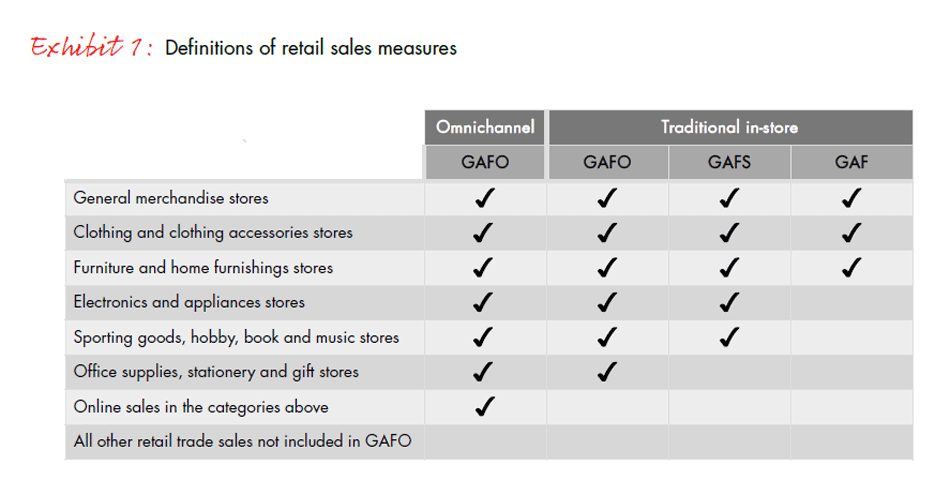
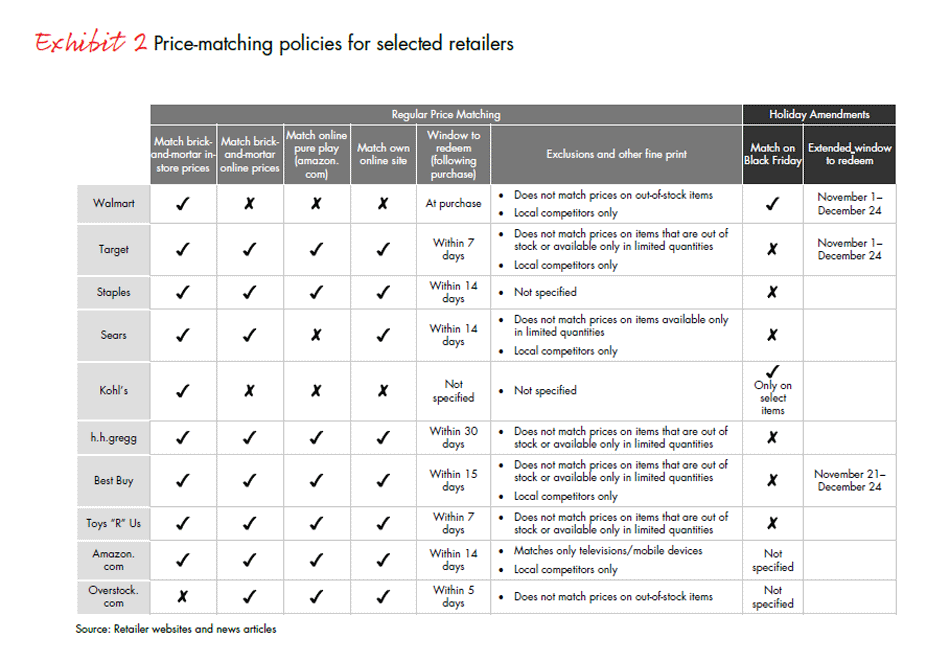
1 PollBuzzerTM offers a real-time consumer opinion survey product. According to PollBuzzer, clients use demographic, geographic and socioeconomic filters to build customized panels drawn from PollBuzzer’s proprietary national respondent pool, build their own surveys using a do-it-yourself Web interface and receive Excel-formatted results in as little as one hour after launch.
2 SaleTally is a retail data firm that tracks marketing and social media information from about 200 nationwide retailers. According to the company, SaleTally offers subscription data services and custom projects to investors and retailers. Bain partnered with SaleTally to track storewide in-store and online discounts for the following nine apparel companies: Abercrombie & Fitch, Anthropologie, Banana Republic, Club Monaco, Express, Gap, J.Crew, Old Navy and Urban Outfitters.
3 A pricing analytics company, 360pi helps retailers make smarter pricing decisions. According to the company, it works with top retailers to enable them to “gain real-time visibility into the market, full awareness of the competitive pricing landscape and the ability to ‘right-price’ to shoppers, which often leads to revenue uplift and higher margins.” For this newsletter, the company tracked pricing across eight categories and 28 retailers.
4 For basket of good analyses, number of items and retailers monitored for each category were as follows: power drills: 7 items, 5 retailers; coffeemakers: 14, 6; video games: 36, 8; printers: 18, 8; digital cameras: 23, 5; tablets: 8, 9; and televisions: 21, 6. Action figures were not included as a basket due to insufficient product overlap across retailers. The analysis was conducted from November 1 to November 30. The Amazon.com pricing used in the analysis did not include third-party “Amazon marketplace” pricing.







